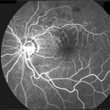Monday, 3 June 2013
Seeing What’s in Your Eye

The structure of your eye is a lot like that of a traditional film camera. The lens of your eye is like the camera’s lens. Your iris is like the diaphragm, and your retina, at the very back of the eye, acts like the light-sensitive film.
However, there is a hole in your retina that lets the axons of its ganglion cells (a kind of neuron) exit the eye while letting blood vessels enter to irrigate all of the retina’s neurons. This hole creates a true “blind spot” in your field of vision. You don’t notice this blind spot in your daily life. (more…)
The Senses | Comments Closed
Wednesday, 22 May 2013
Links on Pleasure and Drugs
 This week, as I have before in this blog, I am posting a set of new links to other web sites that discuss a subject covered in The Brain from Top to Bottom. For each link, I also provide a brief description of the relevant article or other content on the site in question.
This week, as I have before in this blog, I am posting a set of new links to other web sites that discuss a subject covered in The Brain from Top to Bottom. For each link, I also provide a brief description of the relevant article or other content on the site in question.
The subject this week is the sub-topic “Pleasure and Drugs” under the topic “Pleasure and Pain”, and the sites in question all provide insights into the way that various drugs affect our brains. As you see, the first two sites deal with alcohol. It is worth remembering that however legal alcohol may be, it too is a psychoactive substance—in other words, a drug. Many people are getting CBT treatment of addiction to get their lives back on track. (more…)
Pleasure and Pain | Comments Closed
Tuesday, 14 May 2013
Humans Have No Monopoly on Empathy

One rat springs another rat from prison, then shares some chocolate with him. Sounds like a Saturday-morning cartoon, but that’s what actually happened in a laboratory experiment showing that real live rats can display empathetic behaviour.
These findings, published in the December 7, 2011 issue of the journal Science by Peggy Mason and her colleagues, got a huge amount of media play, because this was the first time that scientists had shown that an animal other than a primate can take action to relieve the distress of a member of its own species. And this suggested the possibility that empathy, previously regarded as unique to human beings and some of the great apes, might instead have far older origins in the animal kingdom. (more…)
Emotions and the Brain | Comments Closed
Monday, 6 May 2013
What Are People’s Deepest Motivations?

Economists have long regarded financial gain as one of the primary motives that drive human beings. But research in the cognitive sciences increasingly shows that while money may induce people to work harder physically, it seems to have no effect at all where mental tasks are concerned.
As author Daniel Pink describes in an illustrated talk to which a link is provided below, studies in various countries have shown that giving people more money does not stimulate creative thought, even when the amounts offered are the equivalent of several weeks’ pay. (more…)
Pleasure and Pain | 3 comments »
Monday, 29 April 2013
A Microprocessor That Simulates a Synapse
 For decades now, cognitive scientists across the entire range from cognitivists to connectionists have been trying to use computers to model the learning abilities of the human brain. A team at MIT, headed by Dr. Chi-Sang Poon, has just taken a major step in this direction by designing a microprocessor that can simulate the functioning of a single synapse in the part of the human brain known as the hippocampus.
For decades now, cognitive scientists across the entire range from cognitivists to connectionists have been trying to use computers to model the learning abilities of the human brain. A team at MIT, headed by Dr. Chi-Sang Poon, has just taken a major step in this direction by designing a microprocessor that can simulate the functioning of a single synapse in the part of the human brain known as the hippocampus. (more…)
(more…)
Memory and the Brain | Comments Closed







